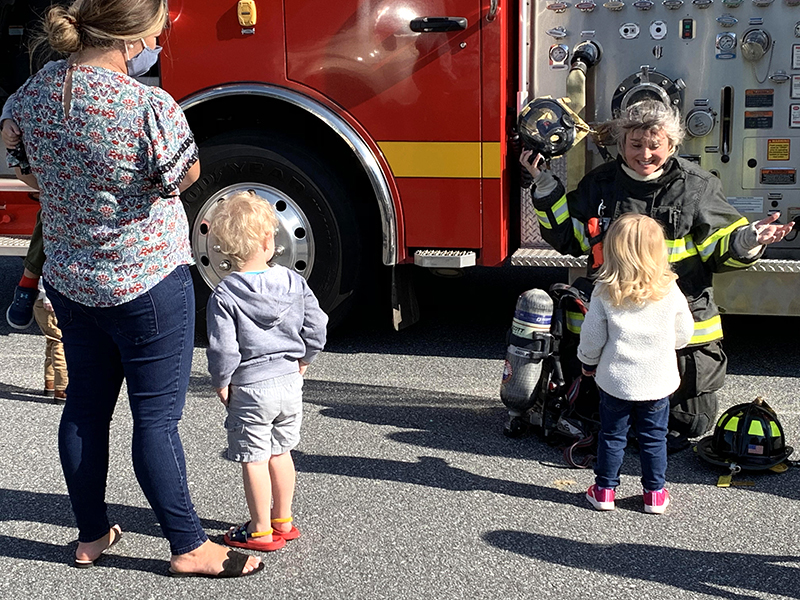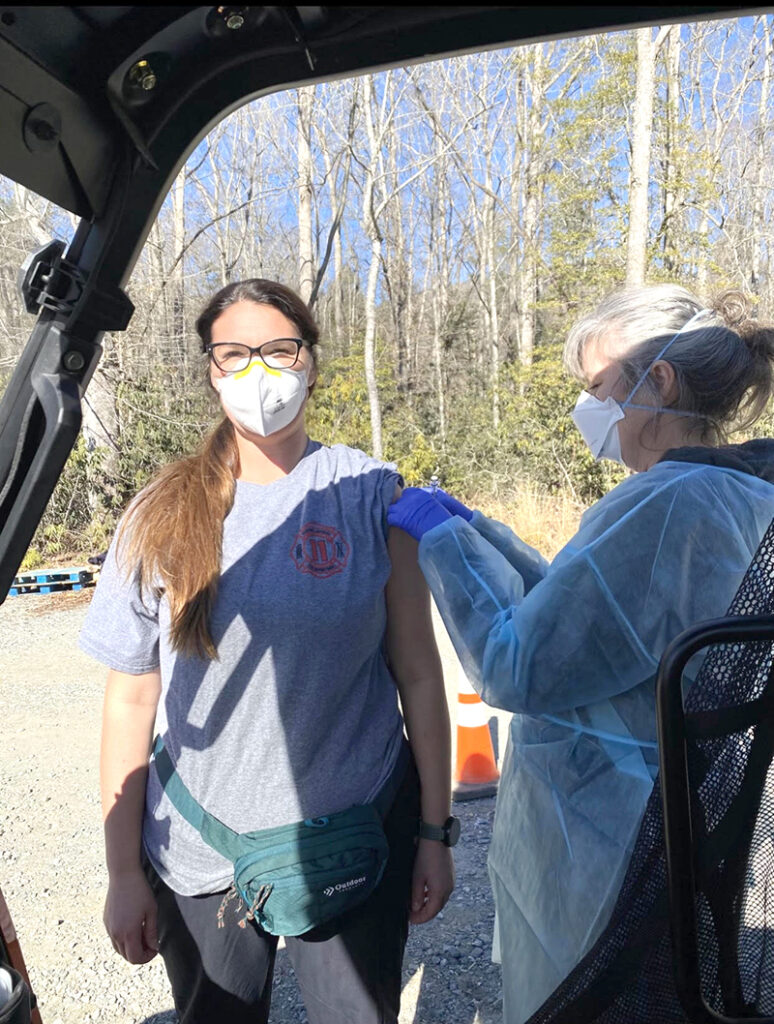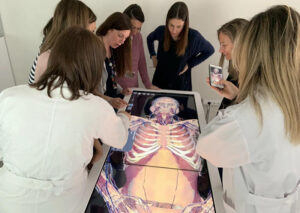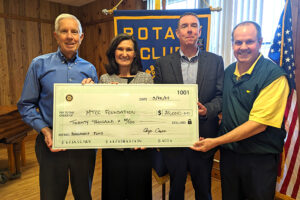Not every volunteer in fire, rescue or emergency medical service can tell you exactly what motivated them to sacrifice countless hours of personal or family time to train to save the lives of others, or why they would put their own lives at risk to extinguish structure fires, rappel down a mountain to rescue an injured hiker or give up their evenings, weekends or holidays to extricate injured drivers and passengers from automobile accidents that are sometimes horrific or lethal.
But Jennifer Morgan, Program Coordinator for Family Resources at Glenwood Elementary School, can tell you exactly the heart-rending reasons that motivated her to become both a volunteer firefighter, as well as an emergency medical technician (EMT)—all while being a mom, full-time school employee, cook for her church’s Women on Mission group, part-time custodian at Glenwood Baptist Church (which she and her family attend), and cook for a monthly PTO and church-sponsored teacher appreciation meal at Glenwood Elementary School.
To be fair, Jennifer married into a family of firefighters and emergency employees. Her husband, Ronald (Ron) Morgan, is a retired fire chief from Lake Lure Fire Department who now directs the McDowell Fire, Rescue and EMS College which will be in session this weekend at McDowell Technical Community College and other locations throughout the county. Ron’s grandfather helped start Glenwood Fire Department decades ago; his dad, Gene Morgan, has been a Glenwood firefighter for 50-plus years; Gene and his brother David are long-time Glenwood firefighters; and David’s daughter, Amberlie Morgan Buff, is 911 Manager for McDowell County 911 Communications Center.

Life As A Bystander
Jennifer knew what she was getting into, though. She started dating Ron when she was 15, and he told her early on that being a firefighter would come first for him. In fact, he left her at their Junior/Senior prom to go on a fire call. She knew what it took to be a firefighter and what time it took. But that was a bystander.
While things are changing now, for a long time, women weren’t really involved as regular firefighters in this area. Ten to fifteen years ago, however, Jennifer became involved as president of Glenwood Fire Department’s Ladies Auxiliary, cooking meals and providing water when firefighters responded to lengthy emergencies or for training events, or providing whatever other support needs the firefighters had. She was close to the action then, but she was, in her words, still a bystander.
She had, in fact, been on fire calls with her husband when he was fire chief at Lake Lure Fire Department or was a volunteer firefighter for Glenwood Fire Department (FD). Sometimes the outcome on those calls was not great, resulting in serious personal injury, property damage and even death. But again, she was a bystander.
Feelings of Helplessness
Things began to come to a head, however, about six years ago, in December of 2016, as best Jennifer recalls. That month, Glenwood FD responded to a structure fire where a mother, father and their kindergarten-aged son lost their life.
“The house was a total loss,” said Jennifer. “The family couldn’t be saved. That really got to me. That little child lost his life. He was in kindergarten here at Glenwood (Elementary).” Glenwood had been teaching fire safety since about 1997, but she and others became more pro-active after this fire, partnering with the American Red Cross to increase fire prevention efforts, including visiting homes in the community to make sure residents had working smoke detectors, considered a key factor in survival in the event of an active fire.
But just weeks later, in March of the following year, tragedy struck again.
Jennifer had woke up late one Sunday morning that month and had to rush to church to unlock doors before people started arriving. She still had on her pajamas and flip flops and only later realized that she had forgotten her cell phone at home. “I am a creature of habit,” she said. “I have a routine for everything, even the order that I unlock doors at the church.” As she pulled in to start unlocking the doors, she happened to see a large black plume of smoke in the distance, and she knew that “…it wasn’t good.” She had been on enough emergency calls with Ronald to know the difference between types of smoke, and she recognized that what she saw was probably the result of a structure fire.
She jumped back in her car and raced down the road, driving as quickly as she could to the home of a friend who lived near the location of the smoke, blowing the car horn frantically as she pulled in. She had her friend to call 911 and then raced on to the house in a bit of a panic.
When she got to the house, she ran up and started banging on doors, hoping to wake anyone who might be inside. She reached to open a screen door, but the smoke and the heat overwhelmed her and she had to back off, but she continued beating on windows and doors as best she could. She knew she needed the fire department.
Although it seemed like forever, members of the fire department quickly rolled in, and she started pulling hose for them. Then came the fateful words that no one wanted to hear as a lady pulled up in a car and ran toward them screaming over and over, “My daughter is in the house.” It turns out that the daughter and her boyfriend were both in the house, but a mother’s instinct is always for her child first.
Jennifer went into “ladies auxiliary mode,” helping the mom, watching as firefighters valiantly tried to fight the fire, but to no avail. She watched as the house burned to the ground.
Both the daughter and her boyfriend died in the fire.
“I’ll never forget the helpless feeling I had that morning,” said Jennifer. She’s replayed the day over-and-over in her head since then, wondering if there might have been a different outcome if she hadn’t forgot her cell phone or if she had worn regular shoes so that she could move faster. Above everything else, she wished she could have done more.
Those feelings of helplessness gave way to a desire to take firefighter training and become more than a bystander. “I wanted to get trained and be an active part of fighting fires,” she said.

Turning Tragedy Into Service
And so she did. Ron was still fire chief at Lake Lure FD then, and she started taking classes there before he retired. Then she moved her membership to Glenwood FD, in the community where they lived, and started taking classes there. She also enrolled in classes at the McDowell Fire, Rescue and EMS College—three times—taking a series of classes which allowed her to participate in live burns, ventilation classes and others.
Besides fire training, Jennifer also started taking emergency medical training to become an EMT, but for very different reasons. When her dad, Randy Lavender, became ill several years ago following a heart attack, she watched as her mom, Mavis Lavender, took care of him. Later, they found out he also had Parkinson’s disease, a debilitating neuro-motor illness. Once again, she recognized that she wished she could do more to help her mom and others in situations like this.
She started taking EMT classes at McDowell Tech in the spring of 2020, just before the start of the COVID pandemic and graduated in December of that year. As vaccines became available, she and her classmates were recruited to assist with shot clinics. She worked every Friday giving COVID vaccines and boosters, and continued right up until last fall, after the last clinics finished at the McDowell Health Department, although the schedule frequency slowed down considerably as time went along.
Now she works part-time for McDowell EMS, going on ambulance calls to wherever she is called. “It is rewarding, but a bit scary at times. As a first responder in the fire department, I work primarily in Glenwood, where I know my community, how to get to different places and where I have long-standing relationship with the people I work with. As an EMT, I am going to different parts of the county, generally with a different ambulance crew each time. I like it, but it has been a learning experience—that unknown element.”
No Regrets
Jennifer doesn’t regret a moment of her firefighter or EMT training, except for not starting earlier. “I was in my late 40’s when I became a firefighter,” she said. “What could I have done if I had started earlier?,” she mused. “I could have worked with my mom or Ron.” (Her mom, Mavis, worked at McDowell EMS before she retired.)
“What I really love and really speaks to my heart is fire prevention,” she said. “I see kids in the hallways at Glenwood (Elementary), and they recognize me from coming to their home to check smoke detectors. They’ll tell me about practicing ‘stop, drop and roll’ and escape plans they have in case of a fire. In the event of a fire, it is the scariest time of a child’s life, and it calms them to see a familiar face to show up at their home to fight a fire. It calms them down. I like to be that person for them. You know you’re making a difference when they come up to you at school and say, ‘Hey! I saw you at my house.’ And if a kid, especially a little girl, grows up to become a firefighter because of seeing me, that’s even better.”
“It’s great to see more women become firefighters, EMT’s and paramedics,” she continued. “We have a lot more to offer besides cooking. Glenwood now has three female firefighters and one junior firefighter, who is also going to school to be an EMT Paramedic.” Junior firefighters generally start as teenagers. At age 18, they can be voted on to join the department and go through a six-month probationary period and training before becoming a full-fledged firefighter.
According to Jennifer, there are not a lot of women in other local departments, but that will likely change over time. In recent years, there has been fewer and fewer people expressing an interest in becoming a firefighter overall, and women are sometimes stepping in to fill the need.
“I want to be involved as much as I can,” said Jennifer. On average, there can be 20-50 calls as a Glenwood firefighter each month, but that varies greatly. At the first of March, there were six calls in just two days. “If I’m available, I going to go. I want to be involved and help out as much as I can. The last two nights, I got no sleep because I was helping run fire calls, but here I am.”
McDowell Fire, Rescue and EMS College
“Whatever the reason a firefighter, emergency medical worker or rescue volunteer comes to ‘Fire School,’ we are glad to be there to assist them with the training they need to become the best at what they do,” said Dr. Brian S. Merritt, MTCC President. “These are the people who put their lives on the line every day to make the world a little safer for the rest of us and, when possible, to make sure we live to see another day. We are thankful for them, their sacrifices and their service.”
To become a firefighter, emergency medical or rescue volunteer, reach out to your local fire department and express your interest, or contact Andrew Pressley at [email protected] or call him at 828-652-3241.



